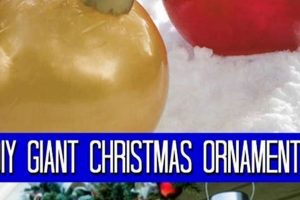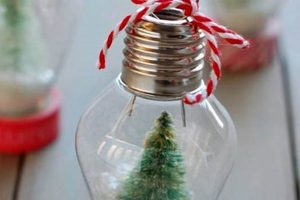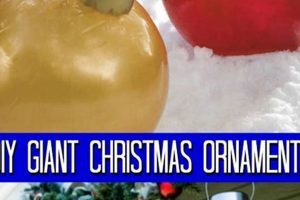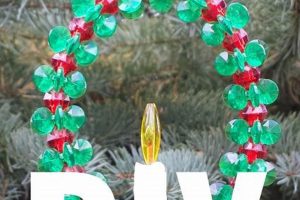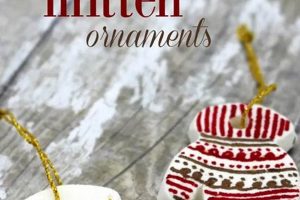Creation of unique holiday decorations involves crafting custom-designed tree adornments, tailored to reflect individual preferences, memories, or relationships. These handmade items offer a departure from mass-produced alternatives, enabling a personal touch in seasonal displays. For instance, a family might create ornaments featuring photographs, significant dates, or personalized artwork.
The practice of designing individualized holiday decor enhances emotional connection and sentimental value associated with festive celebrations. This tradition can foster creativity, encourage family participation, and create lasting keepsakes. Historically, handmade decorations provided an accessible and affordable means of embellishing homes during periods of economic constraint, evolving into a cherished form of artistic expression.
The following exploration will delve into various techniques and materials utilized in crafting custom holiday decorations. It will also address considerations for selecting appropriate designs, personalization strategies, and preservation methods to ensure longevity of these meaningful creations.
Crafting Unique Holiday Adornments
The creation of individualized festive decorations necessitates careful planning and execution to achieve desired aesthetic and sentimental value. The following guidelines offer a framework for constructing durable and visually appealing ornaments.
Tip 1: Material Selection: Opt for materials that are both durable and aesthetically fitting. Consider the long-term preservation of the ornament when choosing between wood, glass, fabric, or polymer clay. Evaluate moisture resistance and potential fading of colors.
Tip 2: Design Conceptualization: Prior to commencing construction, develop a clear design plan. Sketch preliminary ideas, noting dimensions, color palettes, and any personalized elements. This minimizes errors and material wastage.
Tip 3: Secure Fastenings: Ensure all attachments, such as hooks, ribbons, or hanging loops, are firmly secured. Utilize high-strength adhesives or reinforce with stitching when applicable to prevent breakage and loss during handling and display.
Tip 4: Personalization Techniques: Implement personalization using techniques suitable for the chosen material. Engraving, painting, calligraphy, or the application of photographs require appropriate tools and protective finishes to resist wear and tear.
Tip 5: Protective Coatings: Apply a sealant or varnish to safeguard the finished ornament from environmental factors. This prevents fading, scratching, and moisture damage, extending the lifespan of the creation.
Tip 6: Weight Considerations: Account for the weight of the finished ornament, especially if intended for delicate tree branches. Utilize lightweight materials where possible and evenly distribute weight to maintain stability.
Tip 7: Storage Solutions: Implement proper storage techniques after the holiday season. Wrap ornaments individually in acid-free tissue paper and store them in a compartmentalized container to prevent scratches and breakage.
Adhering to these guidelines will facilitate the creation of durable, aesthetically pleasing, and personally significant festive decorations. The resulting ornaments will serve as cherished keepsakes, evoking memories for years to come.
The concluding sections will address advanced customization strategies and explore the integration of technology in ornament design.
1. Material Longevity
The durability and lifespan of the chosen materials are paramount when creating custom festive decorations. Material longevity directly impacts the long-term sentimental and aesthetic value of these creations. If suboptimal materials are selected, the resulting ornament may degrade rapidly, leading to discoloration, breakage, or complete disintegration, thereby negating the efforts invested in its creation and personalization. This is particularly pertinent given that such decorations are frequently intended as keepsakes, passed down through generations.
The selection process should prioritize materials known for their resilience and resistance to environmental factors. For instance, acid-free paper and archival inks are crucial when incorporating photographs or hand-drawn artwork, as these materials resist yellowing and fading over time. Similarly, wood intended for painted ornaments should be properly sealed to prevent moisture absorption and cracking. Failure to address these considerations can result in substantial depreciation in the ornament’s condition, diminishing its personal significance. Consider a family crest carefully painted on untreated balsa wood; within a few years, the wood could warp and the paint could crack, rendering the ornament visually unappealing and emotionally disappointing.
Consequently, material longevity is not merely a practical consideration but also an investment in preserving the memories and artistic expression embodied within custom holiday ornaments. Neglecting this aspect undermines the intrinsic value of these creations, transforming them from cherished heirlooms into ephemeral decorations. Therefore, selecting high-quality, durable materials represents a fundamental step in ensuring the enduring legacy of handcrafted festive adornments.
2. Design Uniqueness
The creation of custom holiday decorations inherently emphasizes design uniqueness as a counterpoint to mass-produced alternatives. The intentional departure from commercially available items allows for the reflection of individual tastes, experiences, and relationships. Absence of design uniqueness renders the endeavor functionally equivalent to purchasing ready-made ornaments, thereby negating the core purpose of crafting personalized items. A lack of distinct design can result in decorations that are indistinguishable from those found in retail settings, diminishing the sentimental value associated with handcrafted objects. For instance, a simple glass ball ornament lacking any personalized embellishments provides minimal differentiation from commercially available alternatives.
Design uniqueness in crafting custom decorations extends beyond mere aesthetic considerations; it embodies the emotional investment and personal narrative embedded within each item. The incorporation of personal photographs, significant dates, or hand-drawn artwork transforms a generic ornament into a tangible representation of cherished memories or relationships. An example of this can be found in ornaments created to commemorate specific life events, such as a child’s birth, a wedding anniversary, or a significant achievement. These ornaments serve not only as decorative elements but also as visual reminders of significant moments in one’s personal history. Furthermore, the act of designing unique ornaments can foster creativity and encourage the exploration of diverse artistic techniques, resulting in decorations that are both visually appealing and personally meaningful.
The cultivation of design uniqueness in creating custom holiday decorations represents a conscious effort to transcend the limitations of mass production and embrace the power of personal expression. The resulting ornaments serve as enduring symbols of individuality, creativity, and emotional connection. Failure to prioritize design uniqueness undermines the fundamental value proposition of personalized holiday decorations, transforming them into mere imitations of commercially available products. The practical significance of this understanding lies in its ability to guide the creation of meaningful and memorable decorations that resonate with individuals and families for years to come.
3. Secure Attachment
The integrity of custom holiday decorations hinges significantly on the security of attachments. The absence of secure fastening mechanisms compromises the structural integrity of the ornament, potentially leading to detachment of components and subsequent damage or loss. This is particularly critical for handcrafted ornaments, where individual elements are often joined using adhesives, wires, or threads. A failure in any of these attachment points undermines the aesthetic appeal and sentimental value invested in the creation.
The relationship between secure attachment and the longevity of custom decorations is causal. Weak or improperly applied adhesives, for example, will deteriorate over time, resulting in the separation of decorative elements. Similarly, inadequate wiring or stitching can lead to the loosening or unraveling of components, particularly under conditions of handling or storage. The importance of secure attachment is further underscored by the fact that these ornaments are frequently displayed in prominent locations and are subject to handling by individuals of varying ages. An example of a poorly secured attachment could be a handmade ornament featuring delicate paper cutouts glued to a wooden base; if the adhesive is not sufficiently strong or resistant to temperature fluctuations, the paper cutouts may detach, rendering the ornament incomplete and aesthetically compromised.
Therefore, meticulous attention to secure attachment is essential to ensure the durability and preservation of custom holiday decorations. Robust fastening methods, combined with appropriate material selection, contribute directly to the ornament’s ability to withstand handling, storage, and environmental stressors. By prioritizing secure attachment, creators safeguard the aesthetic appeal, sentimental value, and overall longevity of their handcrafted festive adornments. Neglecting this crucial element undermines the intrinsic worth of these creations, transforming them from cherished keepsakes into potentially fragile and ephemeral decorations.
4. Personalized Imagery
The incorporation of personalized imagery represents a central component in the creation of custom holiday decorations. The selection and application of such imagery transforms generic ornaments into unique representations of individual experiences, relationships, and sentiments. The integration of personalized visuals provides a tangible connection to memories and emotions, enhancing the intrinsic value of the decorations.
- Photographic Representations
The inclusion of photographs depicting family members, friends, or significant life events personalizes ornaments, creating visual reminders of cherished moments. These images can be directly embedded into ornaments through printing techniques or applied as decoupage elements. The presence of such representations elevates the ornament beyond mere decoration, transforming it into a miniature archive of personal history. For example, an ornament featuring a photograph from a family vacation serves as a recurring reminder of that shared experience each holiday season.
- Hand-Drawn Artwork
Original artwork, created by individuals or family members, adds a layer of unique artistic expression. Hand-drawn images, whether depicting seasonal themes or personal symbols, infuse the ornament with a distinctly personal touch. This form of personalization allows for the expression of individual creativity and artistic talent, making each ornament a miniature work of art. An ornament featuring a child’s drawing of a snowman, for instance, captures a specific moment in the child’s artistic development and adds a sentimental value that cannot be replicated by commercially produced ornaments.
- Textual Personalization
The integration of text, such as names, dates, or significant phrases, provides a direct means of conveying personalized messages or commemorating specific occasions. Calligraphic inscriptions or engraved text adds a level of sophistication and permanence to the ornament. The inclusion of such textual elements transforms the ornament into a commemorative keepsake, marking important milestones or expressing heartfelt sentiments. An ornament inscribed with a couple’s wedding date, for instance, serves as a tangible reminder of their commitment and shared history.
- Symbolic Representations
The use of symbolic imagery, such as religious icons, cultural symbols, or personal emblems, infuses ornaments with deeper layers of meaning. The selection of specific symbols reflects individual beliefs, values, and affiliations, adding a unique dimension to the overall design. This form of personalization allows for the expression of personal identity and cultural heritage, transforming the ornament into a visual representation of individual beliefs and affiliations. An ornament adorned with a specific religious symbol, for instance, serves as a visual expression of faith and a reminder of spiritual values.
The utilization of personalized imagery in crafting custom holiday decorations transcends mere aesthetic considerations; it embodies the emotional connection and personal narrative embedded within each item. The effective integration of such imagery transforms generic ornaments into tangible representations of cherished memories, relationships, and individual identities. By incorporating photographs, artwork, text, and symbols, creators can elevate their ornaments from simple decorations to enduring symbols of personal significance.
5. Protective Coating
Protective coatings are integral to the preservation and longevity of custom holiday decorations. Their application shields the underlying materials from environmental stressors, handling damage, and the natural processes of degradation. The absence of such a coating can significantly diminish the lifespan and aesthetic appeal of handcrafted ornaments.
- UV Radiation Protection
Exposure to ultraviolet radiation can cause fading, discoloration, and structural weakening of materials commonly used in decorative arts, including paints, inks, fabrics, and certain polymers. A UV-resistant coating mitigates these effects, preserving the vibrancy and integrity of the ornament’s surface. For example, a varnish containing UV inhibitors, applied to a hand-painted wooden ornament, will prevent the colors from fading when exposed to sunlight.
- Moisture Barrier
Moisture is a primary catalyst for material degradation, promoting mold growth, corrosion, and warping. Protective coatings act as a barrier against humidity and liquid spills, preventing moisture from penetrating the underlying materials. This is particularly important for ornaments crafted from porous materials, such as wood or paper. A sealant applied to a paper-based ornament, for instance, prevents it from becoming warped or damaged in humid environments.
- Scratch and Abrasion Resistance
Ornaments are subject to handling during placement, rearrangement, and storage, which can result in scratches, abrasions, and the removal of surface finishes. A durable protective coating provides a resilient layer that resists these types of damage, preserving the ornament’s visual appearance. For example, a clear coat applied to a glass ornament provides a protective barrier against scratches that could occur during storage or handling.
- Chemical Resistance
Household cleaners, dust, and other chemicals can react with the surface materials of ornaments, causing discoloration, etching, or dissolving of finishes. A chemically resistant coating shields the ornament from these interactions, preserving its surface integrity. A polymer coating applied to a metal ornament, for instance, prevents corrosion from exposure to acidic cleaners or atmospheric pollutants.
In summary, the application of protective coatings is a critical step in ensuring the long-term preservation of custom holiday decorations. By providing a barrier against environmental stressors, handling damage, and chemical reactions, these coatings safeguard the aesthetic appeal and sentimental value of handcrafted ornaments, enabling them to be enjoyed for years to come. The selection of an appropriate coating should be based on the specific materials used in the ornament’s construction and the anticipated environmental conditions to which it will be exposed.
6. Weight Balance
Weight balance is a critical consideration in the design and construction of custom holiday decorations. The distribution of mass within an ornament directly impacts its stability and visual presentation when suspended from a tree or other display. Imbalances can lead to tilting, drooping, or even dislodging from the supporting branch, thereby detracting from the overall aesthetic and potentially causing damage.
- Material Distribution The selection and placement of materials significantly influence weight distribution. Heavier components, such as metal embellishments or dense clay elements, should be strategically positioned to counteract lighter materials. Uneven distribution can result in a lopsided ornament that does not hang correctly. For instance, if one side of a wooden ornament is heavily adorned with gemstones while the other remains unadorned, the ornament will likely tilt towards the heavier side.
- Hanging Point Placement The location of the hanging point, typically a hook or loop, must be carefully considered in relation to the center of gravity. An improperly positioned hanging point can cause the ornament to hang at an awkward angle or to rotate excessively. For symmetrically designed ornaments, the hanging point should be located at the exact center. However, for asymmetrical designs, the placement requires more precise calculation to ensure balanced suspension.
- Ornament Size and Shape Larger ornaments inherently possess a greater potential for imbalance due to the increased surface area and volume. Complex shapes, particularly those with extended protrusions or asymmetrical elements, further complicate the challenge of achieving weight balance. A large, star-shaped ornament with unequal lengths of points, for example, will require careful weight distribution to prevent tilting or rotation.
- Attachment Method Stability The method used to attach decorative elements also contributes to the overall weight balance. Secure and evenly distributed attachment points prevent localized stress that could lead to instability. The use of strong adhesives or mechanical fasteners, such as screws or rivets, ensures that the added weight is uniformly supported, minimizing the risk of detachment or imbalance. Unevenly applied glue, for instance, can create localized stress points and contribute to an overall imbalance.
The integration of these considerations into the design and construction process is essential for creating visually appealing and stable holiday decorations. Careful attention to material distribution, hanging point placement, ornament size and shape, and attachment method stability ensures that custom creations hang properly, preserving their aesthetic integrity and minimizing the risk of damage or dislodgement.
Frequently Asked Questions
The following section addresses common inquiries regarding the creation of individualized festive ornaments. The aim is to provide clear and concise information to enhance the crafting process.
Question 1: What are the optimal materials for ensuring the longevity of handmade ornaments?
Material selection is critical. Acid-free paper, archival inks, treated wood, and durable polymers are recommended. Protective sealants and varnishes further enhance resistance to environmental factors.
Question 2: How can design uniqueness be effectively achieved in custom holiday decorations?
Design uniqueness can be fostered through the incorporation of personal photographs, significant dates, hand-drawn artwork, and symbolic representations. Intentional deviation from commercially available designs is essential.
Question 3: What techniques ensure secure attachment of components in handcrafted ornaments?
Robust fastening methods, such as high-strength adhesives, mechanical fasteners (screws, rivets), and reinforced stitching, are essential. Attachment points should be evenly distributed to prevent localized stress.
Question 4: How can personalized imagery be effectively integrated into custom holiday decorations?
Photographs can be embedded through printing or decoupage. Hand-drawn artwork adds a unique artistic touch. Textual personalization, such as names or dates, provides a direct means of conveying personalized messages. Symbolic representations reflect individual beliefs and affiliations.
Question 5: What types of protective coatings are recommended for preserving handmade ornaments?
UV-resistant coatings protect against fading and discoloration. Moisture barriers prevent water damage. Scratch-resistant coatings preserve visual appearance. Chemical-resistant coatings shield against corrosive substances.
Question 6: How can weight balance be effectively managed in the design of custom holiday decorations?
Strategic material distribution, precise hanging point placement, consideration of ornament size and shape, and stable attachment methods are essential. Heavier components should be positioned to counteract lighter materials.
In conclusion, careful attention to material selection, design uniqueness, secure attachment, personalized imagery, protective coatings, and weight balance significantly enhances the quality and longevity of custom holiday decorations.
The subsequent section will provide a checklist for diy personalised christmas ornaments crafting.
DIY Personalised Christmas Ornaments
The preceding exploration has elucidated critical aspects of creating custom holiday decorations. Key considerations, including material longevity, design uniqueness, secure attachment, personalized imagery, protective coatings, and weight balance, have been examined in detail. The successful integration of these elements is essential for producing durable, aesthetically pleasing, and personally meaningful ornaments.
The creation of bespoke festive adornments represents a tangible embodiment of individual creativity and sentimental connection. As the holiday season approaches, consider the transformative potential of handcrafted decorations, elevating mere ornamentation into enduring symbols of personal history and artistic expression. The meticulous application of the guidelines outlined herein will result in keepsakes that transcend fleeting trends, preserving cherished memories for generations to come.


